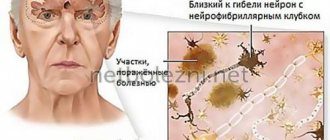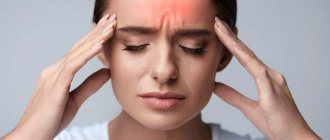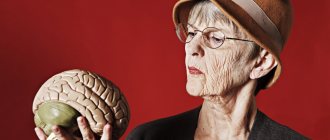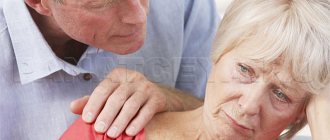With dementia, a person’s main function—cognitive (thinking)—sharply deteriorates. Memory deteriorates, speech is impaired, it becomes difficult not only to work, but also to do simple household chores. The term “dementia” itself is translated from Latin as “feeble-minded.”
Dementia develops more often in older people, but it is wrong to consider its manifestations normal and inevitable. This is an acquired pathological condition that can be prevented, delayed or mitigated with timely measures.
It is important to diagnose dementia as early as possible to prolong your active life and maintain mental clarity. For consultation with a doctor regarding cognitive impairment and diseases of the nervous system, you can contact the Medical Center on Botanicheskaya.
What is dementia and how does it manifest?
Dementia is not a disease in the usual sense of the word. According to the International Classification of Diseases, this is a syndrome, that is, a complex of symptoms associated with a common cause. It is observed in certain brain diseases or develops due to other factors.
One of the first signs of dementia is memory loss. Both long-term and short-term memory weakens: the patient may forget familiar routes and names, ask for the same information over and over again, lose personal belongings, etc. At the same time, the ability to assimilate and process information is impaired.
Additionally, with dementia, at least one group of symptoms from the following list (or several at once) is noted:
- The ability to think logically and solve complex problems is impaired.
- Critical thinking deteriorates. This means that a patient with dementia cannot make decisions and manage money independently; he ceases to see dangers in the environment.
- Speech function is impaired. A person makes mistakes and forgets familiar words, stops understanding phrases in a figurative sense, and pauses when speaking. As the syndrome develops, it becomes increasingly difficult for him to express his thoughts and communicate with loved ones.
- The ability to think in abstract categories is lost.
- The ability to visually recognize objects in space deteriorates. A person has difficulty recognizing people by their faces; he may forget what his house looks like and why the surrounding objects are needed. At the same time, physical vision may remain good - it’s just a matter of cognitive function.
- Human behavior changes and personality disintegrates. The range of interests may narrow, apathy, aggression towards others, sudden mood swings and a desire to avoid social contacts may appear.
Blurring boundaries
One of the main features of the human brain is the desire to classify, divide objects into groups and assign names to them. Every new phenomenon or event, every new person must receive its own name. Everything should have a place on the shelves in our heads. Our love for discrete (clearly separated) concepts comes from this feature. There are apples and there are pears. No pear apples with a ratio of 40 to 60 respectively. Our brain loves clarity, and we obediently follow it, dividing the phenomena of the external and internal world into clear categories. At first, such an approach significantly simplifies cognition and creates a solid foundation for understanding what is happening around us. Imagine what traditional biology would be like without this discrete approach. We would not have classes, families, groups and species and many other names that reflect our species' love of division and classification. How would we exist in such a chaotic world?
The irony is that classifications change over time. Linnaean systematics changed quite a lot under the influence of new biological discoveries, and scientists have repeatedly agreed on how to divide living organisms in accordance with their structure, genetic data or other characteristics. This state of affairs does not mean that all classifications are false. It only tells us that classification is a human tool applicable to objects in the living world. Sorting biological objects into groups is a difficult task.
A much more flexible approach that better reflects reality would be to understand that, despite the discreteness of the categories, we are dealing with a continuum. Of course, there is no continuum between chickens and lizards in real time (chicken lizards and lizards), but there is a continuum of many creatures between lizards now and their ancestors. Here we are talking about an evolutionary process, where changes accumulate gradually; they are small and unnoticeable. They change the body gradually, over hundreds and thousands of years. Fossil forms are not always preserved, and we do not see the entire process. Each ancestor found creates two empty spaces around itself that require filling. We take a discrete approach to the continuum of states and sometimes get controversial and disappointing conclusions. This shouldn't surprise us. Our discrete instrumentation is good, but not ideal for continuum.
What was this conversation about evolution and classification? It was important for us to dive into biological categories, because health and illness, which I will discuss further, are the same biological categories. This is an attempt to describe the states of a living organism (in particular, a person). This is the same discrete instrumentation that is applied to the continuum of states. Many diseases are slow-moving events, which in some sense are similar to speciation. Of course, there are situations in which the disease develops rapidly (injuries, myocardial infarction), but even they can be considered from these positions. For example, we can consider myocardial infarction as a consequence of long-term developing atherosclerosis, and recovery from injury is also a slow process, a movement from illness to health. The approach I describe is not exhaustive, but it does provide some insight into medicine, health, and illness.
Health and illness are discrete concepts superimposed on a continuum of states. In the biological world, neither one nor the other exists. The concept of disease and the concept of health are human inventions. An illness is something that people agree upon as an illness. People got together and decided that this condition is now a disease, but this is no longer a disease. We have released a new international classification of diseases, 11th revision (ICD-11), and the principle there was the same. If you think this is a strange approach, then it works in many areas of human knowledge, and we actively use it there.
Of course, there are conditions that each of us clearly defines as loss of health - for example, a fracture, loss of a limb or one of the senses. Such simplicity and intuitiveness is determined by the fact that changes in the human condition are easily noticeable and do not require additional confirmation - in a laboratory or some other method. Much more questions are raised by processes that are invisible to the eye or carry a subjective assessment. Anemia caused by a lack of iron in the diet would be a good example. It cannot be determined by eye when it comes to a mild degree, but according to tests it is detected quickly, literally in a few hours. So does it exist if we, ordinary people, don’t consider it as such? Another example is dementia. Declining memory and other cognitive abilities are often considered normal for older people, but disease experts don't think so. If the relatives of an elderly person with Alzheimer's dementia do not consider him sick, this does not mean that he is. Here we come across the fact that there are experts who have specialized knowledge in the field of medicine. They decide whether a person has a disease or not, placing him in one of two groups - healthy or sick. Doctors are such experts. They have the important responsibility of drawing the line between health and illness and placing people on both sides of it. This is a difficult task because in reality there is no boundary in a biological sense (Fig. 1).
Figure 1. Diseases as biological conditions are not clearly separated states, but many different forms , between which it is sometimes difficult to draw a clear line. Likewise, it can be difficult to draw the line between health and illness.
Types of dementia and causes of its development
Depending on the causes of dementia, there are several types of this syndrome:
- Dementia due to diseases of the nervous system (also called atrophic). It develops due to damage to brain cells in Parkinson's disease, Alzheimer's disease, Pick's disease and other pathologies. This type also includes dementia with Lewy bodies - pathological formations of a protein nature inside nerve cells.
- Vascular dementia. Its cause can be pathologies of cerebral vessels - from arterial hypertension to stroke.
- Mixed. This type includes dementia that occurs due to a combination of several diseases or risk factors.
Also, the causes of dementia include poisoning with potent drugs and metal salts, metabolic disorders (including diabetes), infectious brain lesions, injuries and tumors, and severe alcohol addiction. These reasons are listed in the medical manual “Dementia” (edited by Academician N.N. Yakhin).
All pathologies and factors have one thing in common: they destroy brain cells. Moreover, the lesion can be focal, because the diseases affect different lobes of the main organ of the nervous system - frontal, temporal, parietal, etc. Depending on the cause and nature of the lesion, the complex of symptoms may also differ when comparing the clinical picture of several patients.
Stages of dementia
An important characteristic of dementia: this syndrome does not just involve intellectual impairment. Dementia is diagnosed only in cases where, due to serious impairments, the patient loses the ability to lead a social life, work and take care of himself in everyday life. Until this point, they speak of a gradual decline in mental function, which can last for several years.
It turns out that dementia itself is the most severe degree of cognitive impairment, when it becomes most severe. However, the syndrome also develops in certain stages.
Depending on the severity of the manifestations, there are three stages of dementia:
- Easy. The patient cannot fully work and communicate with other people due to intellectual impairment, his interest in ordinary hobbies and activities weakens. But at the same time, he remains independent in everyday life and navigates his home.
- Moderate. A person loses the ability to use the simplest household items and appliances without the help of loved ones, and constantly needs accompaniment. However, he can still dress himself, lift a spoon to his mouth, or perform other simple tasks.
- Expressed. Such a patient requires almost round-the-clock care, as he is completely maladjusted. At this stage they talk about the so-called “senile dementia”.
In addition, a distinction is made between focal and global dementia. Focal impairments affect a person's memory and intelligence, but his personality and critical thinking are preserved. Global dementia is characterized by a gradual disintegration of personality, serious changes in behavior, and loss of the ability to think critically.
“The future belongs to preventive medicine”
The development of medical science and the expansion of knowledge about our body, healthy or sick, leads to the fact that medicine penetrates more and more into everyday life. We can cautiously call this process the medicalization of everyday life. An illustrative example of the medicalization of everyday life was the coronavirus epidemic [3], which began at the end of 2021 and continues to this day. Medical procedures have begun to permeate our daily rituals, and conversations about the coronavirus vaccine and treatment have become as commonplace as sharing recipes or discussing politics. Medicine penetrates deeper into our lives than we think. It is not limited to the clinic door and the hospital emergency room. 2021 has shown us how much medical problems can change in our lives - private and public (Fig. 2).
Figure 2. In 2021, we all find ourselves in a new world where there is a coronavirus pandemic. Many of us were very active in discussing a variety of medical issues, such as the need to wear masks.
Myths about Masks and Other Coronavirus Facial Coverings
Historically, doctors dealt with sick people and diseases. The doctor rarely visited a healthy person or vice versa. Contact with a patient occurred when the patient developed symptoms or was concerned about their own health. This almost inevitable negative emotional context of communication with a doctor is an important feature of medical communication. Over time, medical knowledge has significantly changed the world around us, and medicine no longer serves as a tool solely for survival. People began to develop a demand for maintaining health, and not for restoring it. Over time, medicine for the sick began to be supplemented by medicine for the healthy. Traditional medical education focuses on treating disease and restoring health, rather than preserving it. The preventive component in professional medical practice is poorly developed. I think that people do not always understand why they need to go to a doctor for information about maintaining health, because he deals with sick people, not healthy ones.
The result of the discrepancy between the activities of doctors and the demands of people was the appearance in this field of people without special medical education. Bloggers and coaches tell people about a healthy lifestyle, based on publicly available scientific information. It cannot be said that all of them are telling lies or causing harm, but the level of expertise and responsibility for their words among this group of people is usually low. Why should people get a medical education when there is PubMed, Google Scholar, Instagram and TikTok? Although, judging by the quality of the content, for many authors, reading scientific articles and analyzing them for their own audience still remains a prohibitively difficult task.
Of course, there is nothing wrong with people’s interest in maintaining their health. The state, with a reasonable approach, should also have an interest in preserving the health of its citizens. A common theme in discussions of the impact of any disease in scientific research is the economic loss from disability and mortality associated with this disease. Caring for people's health is a long-term investment by the state or a private company, as well as a competitive advantage over other players in this field. This is where the importance of preventive medicine lies. Some diseases are easier and cheaper to prevent than to treat. This is also true for mental disorders.
About types of prevention
Before we get acquainted with the features of prevention of mental disorders, we should better understand what prevention is. Prevention is a set of measures aimed at preventing injuries and diseases. A good example of a preventive measure would be vaccinations - medical interventions that annually save hundreds and thousands of lives of people around the world (read the special project on vaccination on Biomolecule). It should be understood that preventive measures can reduce the risk of a negative event, but do not completely eliminate it.
There are usually two types of prevention:
- Primary prevention is action directed against the occurrence and exposure of a person to risk factors for diseases and injuries. In the case of primary prevention, we try not to create opportunities for harm to health. Primary prevention measures are varied and are implemented at the personal level and at the level of large communities. Hand washing, legal speed limits on roads, safe sex practices and food hygiene are all primary prevention measures.
- Secondary prevention prevents the transition of the asymptomatic course of the disease to clinical manifestations. Secondary prevention includes regular medical supervision of patients from risk groups and changes in lifestyle for representatives of these groups. If we detect a person has high cholesterol levels, but there are no symptoms of coronary heart disease or other atherosclerotic vascular disease, then interventions at this stage will be secondary prevention. This may include diet, increased physical activity and/or medication. As with primary prevention, secondary prevention is largely a matter of changing the lifestyle of a person at risk of developing the disease. Preventing repeated deterioration of the patient's condition with the help of drug therapy can also be classified as secondary prevention.
The famous statement of Nikolai Ivanovich Pirogov, used as the title for this chapter, reveals the direction in the future development of medicine. We have been actively researching mental disorders and other illnesses. Much, although not everything, became clear to us about our illnesses. The time has come to put this knowledge into practical use.
Preventive measures for healthy people usually involve lifestyle changes. They focus on human behavior. These measures help prevent negative events or instill in people the habit of protective actions. Wearing medical masks was and remains an unusual ritual for us, but for China it is a common measure that did not have to be adapted to during the epidemic of the new coronavirus. Preventive medicine is closely related to public health. Sometimes the norms of preventive medicine require enshrinement at the legislative level, and this is a fair decision. We cannot allow people who are carriers of intestinal infections into food production to prevent the emergence of another Typhoid Mary.
An example of a preventative mental health intervention that focuses on behavior would be limiting access to highly toxic pesticides in Asia. Suicide in rural areas in Asia is a serious social and health problem [4]. The number of deaths in this region of the planet caused by self-poisoning with pesticides amounts to thousands of people per year. One of the reasons is the easy availability of highly toxic pesticides to farmers. As researchers of this problem note, farmer suicides using pesticides are usually impulsive. This means that limiting access to pesticides could theoretically reduce the number of pesticide victims. A ban on the storage and use of highly toxic pesticides has reduced mortality from this cause in agricultural areas of Asia. In India, for example, special centralized storage facilities for pesticides were installed, which made it difficult for those who might use them as a means of self-poisoning to quickly access them.
Dementia is a disease of the elderly: how cognitive impairment is associated with age
Dementia is a syndrome that overwhelmingly affects older people. Vascular pathologies, metabolic problems, and diseases of the nervous system often appear in adulthood due to natural causes, and they are the ones that lead to disturbances in mental function.
Moreover, the risk of developing dementia in the elderly increases with age. According to research, among people over 55 years of age, the percentage of cases is up to 8%, while after 80 years of age, the likelihood of experiencing cognitive impairment increases many times (up to 40–45%).
Russian scientists E.E. Vasenina, O.S. Levin and S.G. Sonin calculated that in Russia in 2021 there were 1.7 million people with dementia, and worldwide their number was close to 50 million (based on a scientific article by the named team of authors).
Along with the increase in life expectancy, the number of patients with cognitive impairment will also increase - this is the forecast of scientists. Therefore, early detection of the disease, prevention and supportive care are extremely important.
Physical activity
Prolong your youthful mind with regular physical activity. Exercise helps maintain the volume of the hippocampus, the area of the brain that is primarily affected by Alzheimer's disease. The best ways to prevent dementia are race walking, swimming, cycling, running, and dancing. Set yourself feasible tasks and, if possible, gradually increase the load.
Scientists from the University of Sydney, Australia, have proven that strengthening muscles can make the brain more efficient. They conducted a six-month experiment in which one hundred volunteers aged 55-86 years with moderate cognitive impairment took part. Participants, in addition to exercises to train memory and thinking, worked out in the gym 2-3 times a week, gradually increasing the load. The muscles of the participants who gradually increased the resistance training became noticeably stronger, and they began to perform better on cognitive tests than patients in the control group who did not practice increasing resistance training. Regular strength training not only increased muscle strength, but also improved brain function, positively affecting cognitive abilities.
Work on a personal plot and vegetable garden can also be considered physical activity, because digging up beds, mowing grass with a lawn mower, raking leaves with a rake improves balance and strengthens muscles.
Diagnosis of dementia
Diagnosing dementia can be difficult due to the fact that the range of symptoms and causes that led to cognitive impairment can vary significantly between patients. As a rule, the diagnosis of dementia takes place in several stages and begins with an initial consultation.
To clarify the clinical picture, it is important for the doctor to:
- talk with the patient or person caring for him, collect anamnesis. The doctor uses a questionnaire specially developed for this purpose and finds out when the first signs of dementia appeared and what exactly the cognitive difficulties are. Next, the specialist asks questions about the patient’s lifestyle and health and finds out which risk factors are present;
- assess physical condition - gait, coordination of movements, fluency of speech;
- conduct a short cognitive test using one of the methods accepted in the medical community;
- determine whether dementia is caused by reversible or irreversible causes. This may require laboratory tests.
If the initial conversation and examination is conducted by a therapist, he has reason to suspect the development of dementia, the doctor will refer the patient to a specialized specialist for detailed diagnosis and further treatment.
People often hesitate to see a doctor because they are afraid to hear the diagnosis of dementia and attribute the first signs of the disease to normal age-related changes. But this is a fundamentally wrong tactic, because the earlier the syndrome is identified, the greater the chances of prolonging the usual full life and delaying severe manifestations of the disease.
Is dementia incurable?
Indeed, modern medicine is not yet able to completely reverse the process and cure the onset of dementia. But it is wrong to treat dementia as an irreparable condition in which any treatment is pointless.
It is impossible to do without maintenance therapy, because it can greatly alleviate symptoms, slow down the progression of the disease and improve the quality of life of patients with dementia. In addition, dementia can have a different nature; it is not always caused by incurable neurodegenerative diseases. In some cases, the syndrome is caused by metabolic disorders or infections that can be treated.
Drug treatment of dementia and its features
In some cases, the doctor may prescribe specialized medications to slow the progression of the disease and improve the patient's condition. This may be required, for example, in case of infectious brain lesions, pain syndrome, insomnia and in other situations.
Depending on the type of dementia and its clinical manifestations, the doctor may prescribe anti-dementia, vascular-metabolic drugs, as well as antidepressants, sleeping pills or neuroprotectors. If dementia is accompanied by vascular pathologies or metabolic disorders, medications indicated for these conditions may be prescribed.
However, do not forget that uncontrolled use of medications is dangerous. After all, drugs that stimulate improvements in one type of dementia are often contraindicated in cognitive impairment of another nature.
What else is important to know about drug treatment for dementia:
- It is important to take medications prescribed by a specialist regularly, otherwise their effectiveness will be low. It is important for people caring for patients with dementia to understand that an elderly person with cognitive impairment cannot control their medication intake on their own and needs ongoing assistance. In this case, medications should be stored out of reach and given in strict dosages.
- Most medications do not give immediate results. The first improvements can usually be expected within a few weeks after starting therapy.
- Medicines are prescribed for a short period of time (usually up to 3 months), and then it is important to talk with the doctor again and adjust the therapy so that it really effectively resists the development of dementia.
- Be aware of side effects and possible incompatibility of different drugs with each other. So that the doctor can correctly select medications and, if necessary, find replacements for them, it is important to inform the specialist about all medications that a person with dementia is taking.
Non-drug treatment methods
Non-drug methods of maintenance therapy for patients with dementia can also effectively influence the cognitive sphere. They are used simultaneously with taking medications prescribed by the attending physician.
The advantage of these methods is that they have no contraindications and are used for any type of dementia, except for the most severe stage.
What methods of restoring cognitive function are indicated for dementia:
- Cognitive training. During the training, simple fragments of poems are memorized, passages of text are read aloud, and other exercises are performed.
- Cognitive stimulation. It involves influencing different senses, and is often carried out in a group. The activity may include warm-up, simple games, singing, dramatization, riddle solving and other activities.
- Biographical training. Since long-term memory is often affected in dementia, it is helpful to repeat and reconstruct past events.
- Music therapy, art therapy. The interest of patients with dementia in the outside world fades over time, so it is important, at least during special classes, to maintain contact with the field of art, to continue education and development in a simplified form.
- Diary entries. The practice of keeping a diary is not only useful for maintaining speech function, but also allows patients to record their own emotions and experiences.
- Walking and light exercise - physical activity in any form is highly desirable.
It is important to conduct classes daily, devoting enough time to them to get a positive effect.
Useful exercises for brain training
Special exercises can help to stimulate the brain cognitively. They can be performed independently or together with your loved ones. The main condition is their regularity.
Here are some examples of effective activities:
Place in front of you a piece of paper with a list of words written in different colors. You should start with the first word. But you need to name the color in which the text is written. After you reach the end, the words must be repeated in reverse order. It can be difficult at first, since different hemispheres of the brain are responsible for the perception of text and color.
Benefit: helps to establish new connections between the hemispheres of the brain, and also trains concentration and attention switching.
When performing this exercise, you should focus on the number “19” in the center of the square. Then you need to look for “1” and then all the other numbers in ascending order. You can draw the table yourself, and arrange the numbers in the cells in any order. This activity increases the speed of perception and processing of information and promotes the development of peripheral vision.
In older people, thinking, memory and speech are directly dependent on hand movements. In this regard, activities such as knitting, embroidery, or other activities that involve fine motor skills are helpful in maintaining mental clarity.
Fold the fingers of your right hand so that they show the “peace” sign, and show “ok” with the fingers of your left hand. Then, take turns changing your finger shapes so that your left hand shows “peace” and your right hand shows “ok”. Repeat several times. Then try doing this exercise with your right and left hands at the same time. Such gymnastics trains attention and the ability to quickly switch from one task to another.
Take two blank sheets of paper and two pens. The task is to draw geometric shapes with both hands at the same time. Instead of shapes, you can write letters or words with the same set of letters. Synchronous writing trains the brain to cope with several tasks simultaneously, involving both hemispheres in the work.
Prevention of dementia: how to prevent the development of the syndrome
Unfortunately, it is impossible to completely protect yourself from cognitive impairment: they are often provoked by unpredictable and not fully explained by science pathologies (which include, for example, Alzheimer's disease).
However, several areas of dementia prevention are recognized worldwide. They are effective because approximately 35% of dementia is due to modifiable risk factors. By eliminating these factors in advance, you can reduce the risk of cognitive impairment in old age.
What preventive measures are the most effective and important:
- Physical activity. It is physical education that today is considered the basis of prevention, since it has a complex effect on the body and prevents direct and indirect risk factors. It is important to systematically engage in physical activity throughout your life or start as early as possible before cognitive function begins to decline. Intense training brings particular benefits to the brain, but if there are contraindications for it, do it to the best of your ability, appropriate for your age. Physical exercise not only affects the psychological state of a healthy person in the present, but also protects nerve cells and can prevent intellectual decline in the future.
- Maintaining body weight within normal limits. Obesity, and as a result vascular diseases and diabetes, are serious risk factors that are best avoided.
- Treatment of arterial hypertension. If this disease is detected at an early age, it is important not to let it take its course and be registered with a cardiologist. The goal of this area of prevention is to restore the health of the cardiovascular system before disruptions in its functioning provoke irreversible damage to brain cells.
- Mental activity and multi-stage education. To ensure that cognitive functions do not suffer in old age, it is important to give the brain sufficient and constant load. It has been proven that people who only completed primary school and stopped studying at age 11–12 have a one and a half times higher risk of cognitive impairment. At the same time, complete secondary or higher education significantly reduces the likelihood of developing dementia.
- Quitting smoking and drinking alcohol. Destruction of brain cells under the influence of ethyl alcohol or nicotine is one of the indirect causes of dementia, which should be excluded in advance.
- Active social life. Lack of social interaction and voluntary isolation at an early age may also be risk factors. Therefore, it is important to maintain a sufficient number of contacts with colleagues, friends and loved ones.
- A healthy diet, which must include fruits, vegetables and fish, and it is better to reduce the percentage of meat and dairy products. This is the so-called Mediterranean-type diet, which has a beneficial effect on the condition of blood vessels and the body as a whole.
An infinite number of the most “beautiful” forms
Now is the time to expand our reasoning. We have pointed out that health and illness are not simply discrete categories, but rather a spectrum of states with no clear transition when viewed as biological entities. I think it is worth adding arguments in favor of this idea and highlighting the problem from different angles.
When we talk about the transition between health and disease, and the reverse movement, we understand that the path to disease consists of many small steps - minimal changes in the tissues of our body. These are mutations, immune processes, cell growth or death, accumulation of unnecessary substances or increased consumption of necessary ones. At some point, the changes become so significant that symptoms, laboratory changes, or changes visible on ultrasound or MRI appear, and from that point on we record the disease. But when did it start? Did it begin with the first mutation in the future cancer cell or with the first dying cardiomyocyte? This question is often meaningless in practice, but for our reasoning it is of great importance.
In large studies, doctors and scientists have discovered various features that increase the risk of developing the disease. These features have been called risk factors. Smoking, high cholesterol, and low physical activity are risk factors for cardiovascular disease. For many diseases, such risk factors can be found. For schizophrenia, for example, this would be the use of cannabinoids. This tarnishes marijuana's reputation as a "safe" drug. However, individual substances in marijuana are still used as medicines [1], and psychedelic therapy is gaining popularity among researchers [2]. The identification of risk factors and other research have created a world where, in addition to health and disease, there are also pre-disease conditions. This concept better reflects a continuum of states than two discrete categories. For example, in patients with schizophrenia, cognitive impairments are described that precede the development of psychosis itself, and in Alzheimer's disease, beta-amyloid begins to be deposited before the first symptoms of dementia appear. The disease doesn’t seem to exist yet, but it already lives in our body.
An additional difficulty is that often such signs are probabilistic, and it is not possible to strictly link them with the development of the disease. There are rarer examples in which what exists before the symptoms definitely points to the development of the disease in the future. In Huntington's chorea, one mutation determines whether you get the disease or not. If you are a carrier of this mutation, then there are no options - the disease will develop unless you die before the age of its onset. Does a carrier of this mutation suffer from Huntington's chorea? Biological research in medicine has shown us the complexity of such issues. We saw that everything is not as simple as we thought. We saw how things are in reality.
Another side of the problem of distinguishing between illness and health is the understanding that illness of one organ does not mean illness of the whole body. Let's say I have gastritis - am I sick or healthy? But it’s just the stomach, not the whole body. It turns out that there is more healthy in me than sick. This means I am more healthy than sick. These are strange thoughts, but they are relevant in the context of the continuum of health and illness. There are processes that affect us more than others. Advanced stomach cancer affects us more seriously than the flu. Both are diseases, but one of them is more “healthy” than the other. However, we have not yet touched deeply on the topic of self-perception. Am I really sick if I don’t consider myself sick? How do I react to my illness? And—in the case of a mental disorder—where do we draw the line between the normal me and my illness? These questions are complex and unlikely to have a clear and definitive answer, but their formulation and discussion are important for the development of medicine.
Diagnosis and treatment of dementia in Moscow
Senile dementia has a reputation for being incurable, but it is important to remember that some forms are preventable. In addition, even if the affected brain cells cannot be restored, proper treatment can slow down degenerative processes and significantly improve the quality of life of a person experiencing the syndrome. For any type of dementia, the patient must receive the necessary drug and non-drug therapy, as well as full care, help with everyday life and moral support.
You can contact the specialists of the Medical Center on Botanichnaya for detailed advice on the prevention or treatment of dementia. Remember that it’s not the diagnosis that’s scary—it’s the ignorance and lack of qualified help at a time when a lot depends on it.










